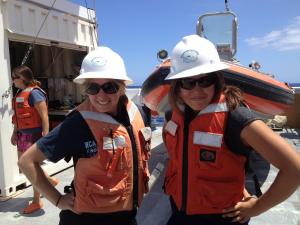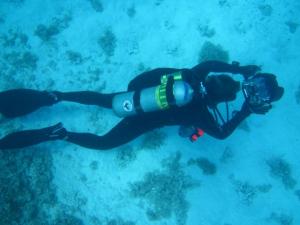UH students and staff return from 24-day research expedition
Exploration of the Papahanaumokuakea Marine National Monument completed
University of HawaiʻiContact:
Posted: Aug 31, 2012

HIMB PhD candidate Nyssa Silbiger with graduate student Maya Walton on-board the NOAA ship (Wiener).
On Friday, August 24, 2012, the NOAA ship Hiʻialakai returned to port following a 24-day research trip to explore coral reefs at Papahānaumokuākea Marine National Monument in the Northwestern Hawaiian Islands.
The scientific party consisted of staff from NOAA's Office of National Marine Sanctuaries, NOAA National Marine Fisheries Service, the University of Hawaiʻi and Scripps Research Institute. University of Hawaiʻi students also participated in the expedition, including five undergraduate students from the Hilo and Manoa campuses, as well as Windward Community College, and three graduate students all from the Hawaiʻi Institute of Marine Biology.
The team visited French Frigate Shoals, Lisianski Island, Pearl and Hermes Reef, and Kure Atoll and conducted ecological assessments of reef fish, corals, invertebrates and algae, and other activities.
Graduate students, Nyssa Silbiger and Johnathan Burns were able to participate on the expedition to conduct their own graduate research. Doctoral candidate Nyssa Silbiger had a very successful trip collecting 75 calcium carbonate blocks that she distributed on several coral reefs in the Monument during the last expedition one year ago. These blocks will help her determine the rates of bioerosion (natural erosion) of the coral reefs both in the Northwestern and Main Hawaiian Islands.
This was Silbiger’s third expedition, but she still values every opportunity. “I feel really lucky to have had the chance to go up to the Northwestern Hawaiian Islands,” she said.
John Burns, another Hawaiʻi Institute of Marine Biology PhD candidate, further reiterated, “You get to go to environments that are so unique, it is pretty amazing to see the different reef structures first-hand.”
Raised on Lanai, Windward Community College student and COSEE Island Earth employee Megan Onuma, who experienced the Northwestern Hawaiian Islands for the first time, said, “It has been very cool to be able to go out with so many scientists and learn what they monitor and do. This is a life-changing experience.”
Efforts to expand the experience to other educational institutions were made through the COSEE Island Earth Program in conjunction with the Papahānaumokuākea Marine National Monument. Ten public and charter schools statewide were treated to ship-to-classroom “ask a scientist” sessions via email, and will receive follow-up classroom visits with researchers for a more hands-on experiences.
COSEE Island Earth program manager Carlie Wiener stated, “We hope that the students get an opportunity to understand what a special place the Papahānaumokuākea Marine National Monument is, and that the students understand what an honor it is to have this large marine protected area in their own backyard.”
For more information on the trip, visit the expedition's blog at www.papahanaumokuakea.gov/education/RAMP2012.html.

